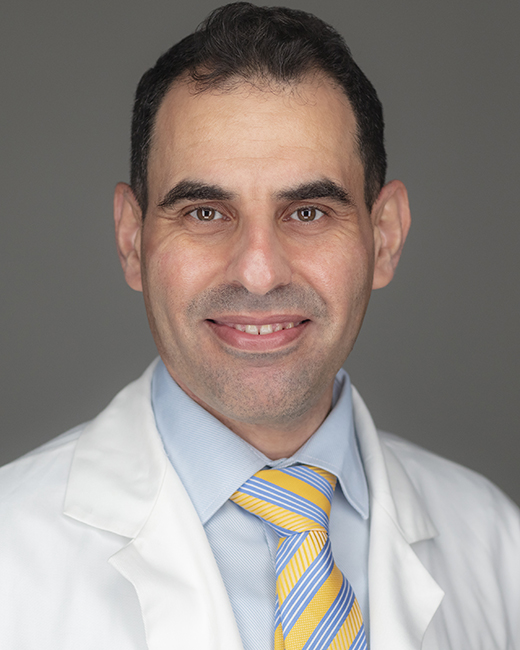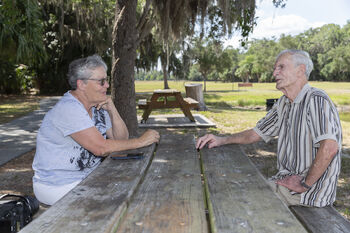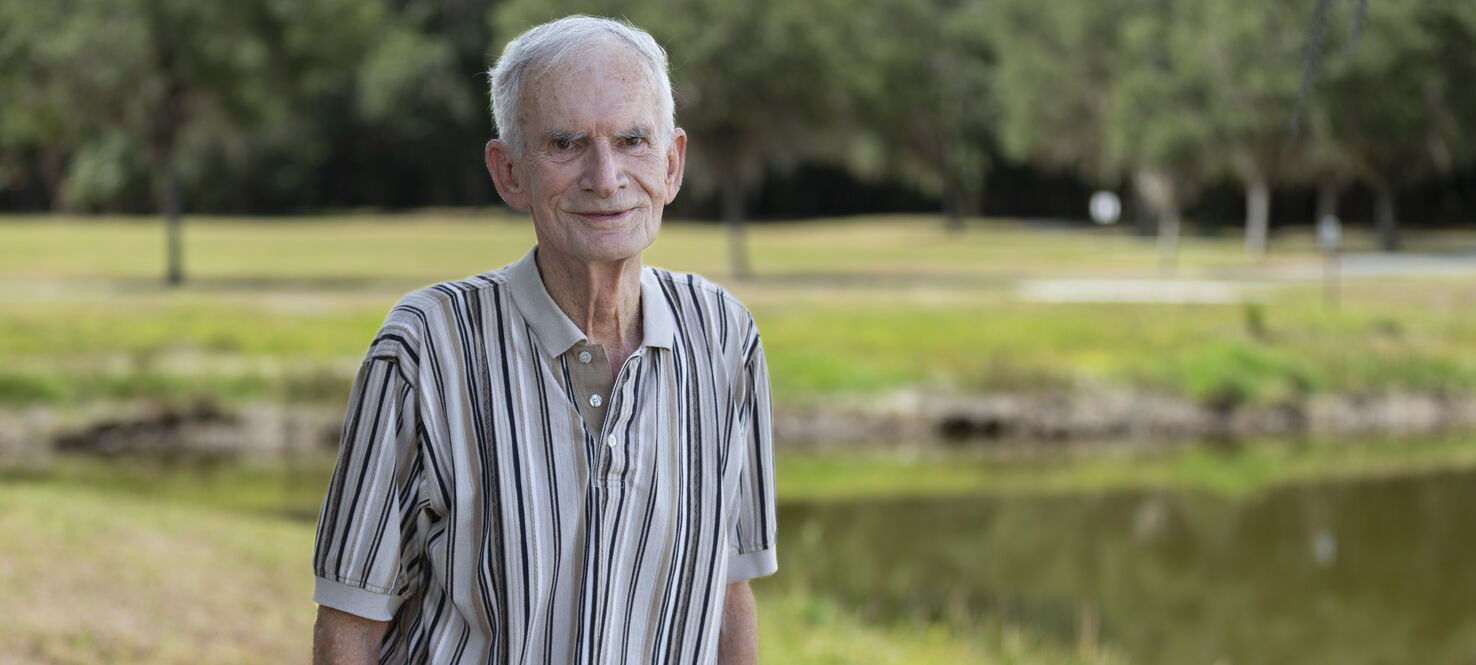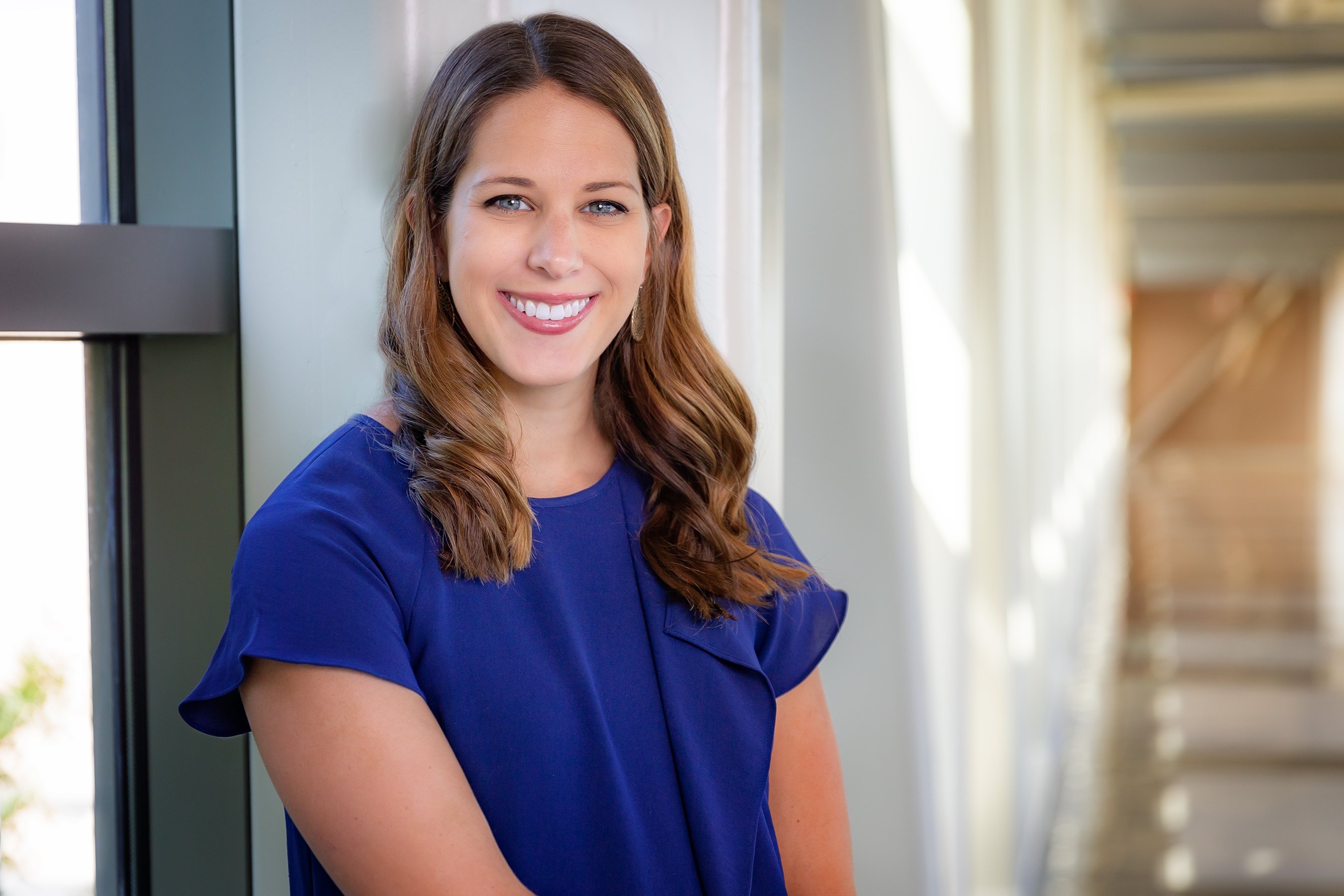Geriatric Surgery Clinic Breaking the Age Barrier
James Sandridge was shocked that he was discharged from Moffitt McKinley Hospital just four days after major surgery.
“What did I do wrong?” he joked to his nurse. “You’re throwing me out early!”
James had packed a bag for an estimated two-week hospital stay after surgeons removed a tumor in the center of his liver in January 2024.
It was record recovery time for the 79-year-old retired U.S. Air Force master sergeant. When he was diagnosed three months before, he and his wife, Dana, were concerned he wasn’t fit enough to survive the surgery.
“I thought, this is it. I am done. I am a goner,” James said.
But thanks to Moffitt Cancer Center’s new Geriatric Surgery Program, which assesses older patients’ health and well-being and optimizes them for surgery, James went into the operating room the fittest he had been in decades.
“He was in his best physical shape, 100%,” Dana said. “If they had done the surgery right when they told us he needed it, I don’t know what would have happened because he was not in good shape.”
Assessing Fitness for Surgery
Geriatric oncologist Mohammed Al-Jumayli, MD, says a silver tsunami is coming.
A recent study found that people older than 65 will account for almost 70% of new cancer diagnoses by 2030. Within that age group, the subset of patients age 85 and older is also on the rise.
“Cancer is a disease of older adults, and with the improvement in screening for different types of cancer we can now detect cancer at an earlier stage, which means patients have a chance to have surgery,” said Al-Jumayli, an expert in Moffitt’s Senior Adult Oncology Program.
However, many older patients report that community surgeons do not want to operate on them based solely on their age.
A review of 10 years of electronic medical records and data collected by comprehensive geriatric assessments for patients 70 and older shows Moffitt is performing more surgeries for older adults — including those 80 and older — than any other hospital that has published data.
“We also found that older adults who are ‘fit’ based on a frailty index have better outcomes, and even outcomes almost similar to younger adults,” Al-Jumayli said.
To better assess a patient’s fitness and optimize patients 75 years and older for surgery, Moffitt’s Geriatric Surgery Program opened the Geriatric Perioperative Optimization Clinic in 2023. Patients who are determined high risk by a standard geriatric screening tool and anyone over 85 can be referred to the clinic prior to surgery. There, providers perform a more in-depth geriatric assessment using a surgical risk calculator and assessment that looks at factors like physical fitness level, mobility, cognition, functional independence, comorbidities and mental health to assign a score reflecting the individual’s readiness for surgery.
“Not only are we looking at a patient’s labs or medical history, but we are evaluating them in 360 degrees — their functional abilities, psychosocial state, nutrition and cognition. We found from these data that if we identify these and personalize management accordingly, we will improve long-term survival and increase patient satisfaction,” Al-Jumayli said.
After initial screening, a patient receives a score between zero and 20. Those who fall into the vulnerable, mild, moderate or severe categories are referred to supportive services to get them in better shape before surgery and reduce the risk of postsurgical infections, falls and blood clots and shorten hospital stays.

“Most patients who come to me aren’t as active anymore and have lost weight,” said Heather Freeman, a nurse practitioner who runs the Geriatric Perioperative Optimization Clinic and has helped optimize more than 60 patients for surgery.
“Everyone knows what a marathon is and how long people train before they run the race. Surgery is a marathon for these older patients, and it’s not as simple as coming in and laying on the table. If they make themselves stronger prior to surgery, that can better the outcome.”
To make the patients stronger, they are referred to a Moffitt dietitian and physical or occupational therapist. The Geriatric Perioperative Optimization Clinic also focuses on the emotional toll surgery can have on a patient, making sure patients have the proper support team at home and helping patients complete advance directives.

Nurse practitioner Heather Freeman helps older patients get in shape for surgery as part of Moffitt’s Geriatric Perioperative Optimization Clinic.
Freeman says the clinic visits help patients and families better understand not only the surgery ahead of them but the recovery and postoperative risks. Their conversation has helped a few patients decide that surgery wasn’t the right choice for them, and those who do move forward with surgery feel more educated and prepared.
“Most patients feel very relieved that we have been able to answer their questions,” Freeman said. “When they are at their surgery visits, it is very stressful. So this allows them to be able to go home and recap and then come back and see me where I can focus on how we can make this better for you and how can you do better.”
‘Best Shape of My Life'
Already a skin, prostate and kidney cancer survivor, James thought his battles with cancer were over. He had been cancer free for years when his primary care physician suggested he undergo lung cancer screening due to his smoking history. The CT scan showed his lungs were clear. However, he had a suspicious spot on his liver. A biopsy confirmed it was cancer, a metastasis from his kidney cancer.
The airman who spent 26 years flying to many countries during conflict and peaceful times didn’t believe he had any fight left. But his wife, Dana, refused to let him give up.
“I said, ‘No, you have a 6-year-old granddaughter, and you are going to her graduation,’” Dana recalled.
Dana had to be strong for her husband of 46 years, but deep down she was terrified. After hearing the diagnosis, she told James she was going shopping but just found a place to park her car and sobbed.
James’ recovery after a 2012 surgery to remove his kidney was difficult. But this time, a visit with Freeman at the Geriatric Perioperative Optimization Clinic helped turn his family’s fear into confidence.

James and his wife, Dana, have been married more than 40 years. Although she was worried about the surgery, she took comfort in how prepared he was this time.
“I felt so much better about this surgery than I did before his last one,” Dana said. “His first cancer surgery we were both scared and things were being thrown at us, but sitting down and talking about this one in the clinic made the world of difference.”
Not only did Freeman help put the Sandridges’ minds at ease, but she also helped James get in better physical shape before surgery. She enrolled him in an exercise prehabilitation pilot trial for older patients undergoing liver surgery. In the trial, run by exercise researcher Nathan Parker, PhD, and his team, patients are given Fitbits and participate in an individualized resistance training regimen via Zoom twice a week.
James, a self-proclaimed “couch potato,” was extremely motivated to get in better shape in the two months he had before his surgery. He fastened his resistance bands to his front door and completed as many repetitions as possible while standing. When that became too difficult, he would do as many as he could sitting.
He also met with a dietitian and changed his eating habits to focus on a high-protein diet.
By the time he approached his surgery date, James had seen impressive results. He no longer walked hunched over from sciatic nerve pain and could see visible muscles in his legs again.
“I was in the best shape of my life,” James said. “That made me feel so much better about the surgery. I was still scared because you always have in your mind that this could be it, but I decided I was going to have fun and make it fun for everyone else involved.”

Daniel Anaya, MD
He was still joking with the nurses when he was wheeled back into the operating room.
Surgical oncologist Daniel Anaya, MD, removed the center of James’ liver where the large tumor was located. While it’s a more complex surgery that involves cutting the liver in more than one place, it would remove only about 30% of the liver. A traditional liver resection in this case would involve removing over 70% of James’ liver. This could lead to more complications and a longer recovery time.
“For a patient like this, that could be the difference between life and death,” Anaya said.
The surgery was a success, and after James’ early eviction from the hospital, he returned home to continue his newfound healthy lifestyle. He’s convinced his presurgical optimization made all the difference, and just months later, it’s impossible to tell he recently underwent major surgery.
“I had a tooth pulled last week, and I told Dana, ‘If I had a choice of going through the liver surgery or getting another tooth pulled, I would pick the liver.’”
Improving Outcomes Across the Board
The successful surgical treatment of patients like James proves the value of the Geriatric Surgery Program and the need to expand the Geriatric Perioperative Optimization Clinic. The majority of patients referred to the clinic have gastrointestinal, head and neck, and genitourinary cancers, but the goal is to have all departments across the cancer center referring patients for optimization.
Moffitt is also in the process of obtaining Geriatric Surgery Verification from the American College of Surgeons. The verification consists of 32 standards designed to improve surgical care for older adults. There are only 10 hospitals in the U.S. that hold the verification. Moffitt hopes to be the first in the Southeast as well as the first cancer center.
“We are really taking into consideration what matters most to each patient. For geriatric cancer patients, it’s not only about the cancer and surviving, it’s more about their day-to-day quality of life,” said Anaya, the director of Moffitt’s Geriatric Surgery Program. “We are focusing on all the areas that are unique to the geriatric patient population.”
Florida is the state with the largest population of people 65 and older, and Anaya estimates older patients represent upward of 50% of surgical patients at Moffitt.

James has been doing well since his successful surgery, and he has continued to live a healthy lifestyle.
While the Geriatric Surgery Program at Moffitt continues to work on rolling out all the required standards across the institution to achieve verification, it is already doing many things that improve care for older patients. In addition to the Geriatric Perioperative Optimization Clinic, the team has improved care with initiatives like creating geriatric screening tools across the preoperative clinics, developing a quality-of-care dashboard for geriatric patients and placing clocks in every postsurgical hospital room to help ensure patients don’t get disoriented.
A committee of about 40 team members representing all the different surgical specialties and perioperative teams has been assembled and hopes to complete the remaining standards to achieve verification in the next year or so, with the ultimate goal of improving pre- and postsurgical care for all older patients.
For patients like James, that means getting sent home from the hospital with a suitcase full of clean clothes and more time to spend with their grandchildren.
This article originally appeared in Moffitt's Momentum magazine.




